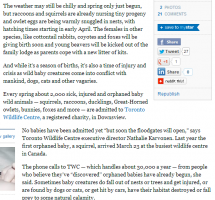 According to a March 21, 2013 article in the Toronto Star, springtime ushers in a surge of wildlife growth in Toronto that can be problematic for both people and animals. The article adds that most people who chance upon motherless nests think that the baby animals (whether they’re bunnies, raccoons, or something else) have been “abandoned,” when the mothers are, in fact, just foraging for food nearby. Local residents are thus advised to leave animal nests alone as much as possible—unless, of course, wild animals start making a mess of their own homes.
According to a March 21, 2013 article in the Toronto Star, springtime ushers in a surge of wildlife growth in Toronto that can be problematic for both people and animals. The article adds that most people who chance upon motherless nests think that the baby animals (whether they’re bunnies, raccoons, or something else) have been “abandoned,” when the mothers are, in fact, just foraging for food nearby. Local residents are thus advised to leave animal nests alone as much as possible—unless, of course, wild animals start making a mess of their own homes.
Once the animals start nesting within human settlements and begin making a ruckus, they’ll need to be taken out before further damage is done. Killing unwanted critters should be the last resort, however, since it is certainly not a humane way to deal with encroaching wildlife. Irresponsible wildlife handling not only leaves baby animals orphaned but also increases the strain on facilities like the Toronto Wildlife Centre. Luckily, homeowners can hire wildlife animal removal experts like Skedaddle who can capture invasive critters using humane and manual methods before releasing them into the wild.
Animals are naturally attracted to human homes primarily because of the food they can gather or scavenge. Raccoons, for instance, have frequently been spotted looting the garbage cans of Toronto residents during the evening. Another reason why wildlife wind up in people’s houses is because man-made structures provide easy shelters from the elements.
Meanwhile, as these critters prepare for breeding season, their feeding and nesting activities are likely to intensify. Homeowners should expect even more rampant raids from racoons and squirrels, and possible infestations of bats and mice within their homes. At the same time, humans must show respect by not disrupting wild animals’ habitats.
There are various humane ways to keep small animals off your property without necessarily wiping out their entire local population. For instance, you can secure garbage bins and install feeders for birds such that not even the craftiest raccoon or squirrel can gain access to these potential food sources. Additionally, any holes in your foundation should be sealed to discourage wildlife from invading the house. Such modifications should ideally be made way before April which, as the article points out, is when most animals start nursing their young.
For more persistent critters, however, homeowners might want to call up GTA wildlife removal experts like Skedaddle. These professionals will scour each affected property for unwanted birds, bats, or rodents then return the captured animals to their natural habitats in the wild. Homeowners are likewise cautioned against attempting to capture wild animals on their own, especially raccoons who can fight back viciously when provoked.


